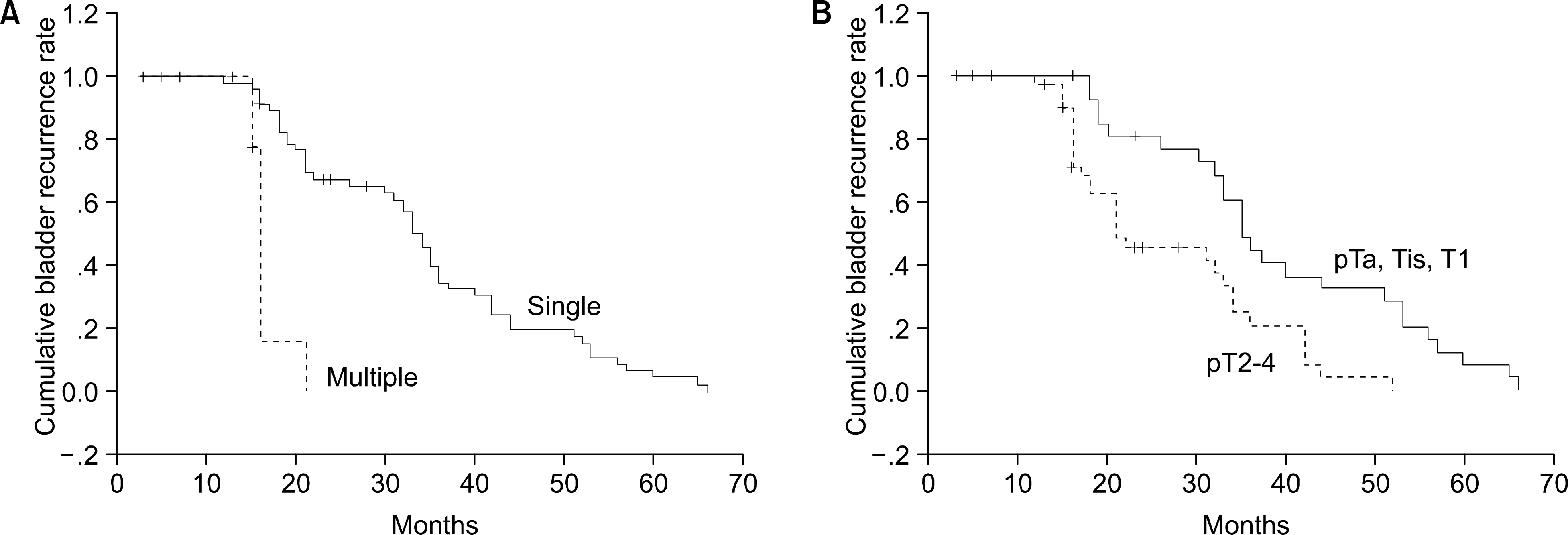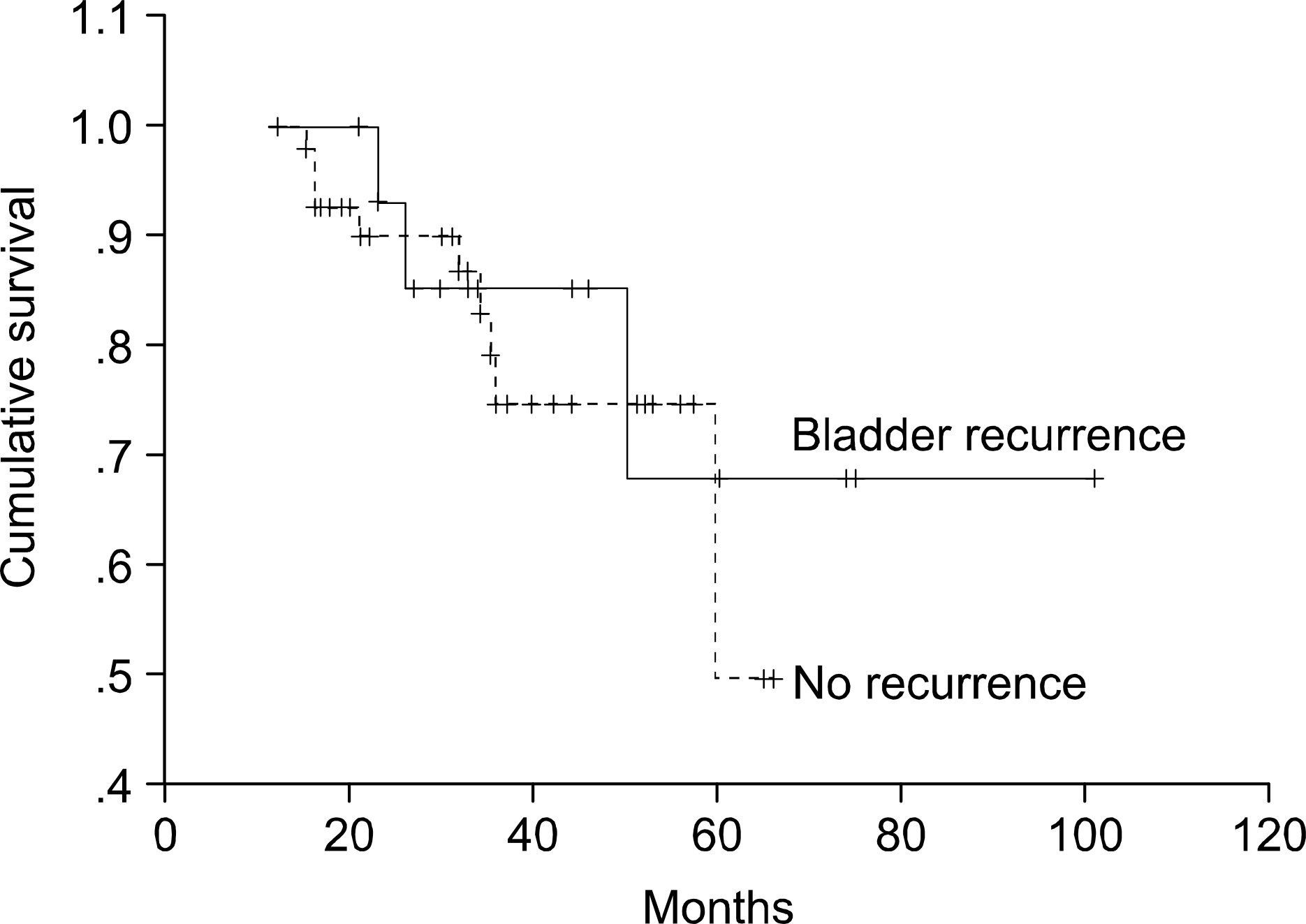Korean J Urol.
2006 Oct;47(10):1035-1040. 10.4111/kju.2006.47.10.1035.
Risk Factors for Subsequent Bladder Cancer Recurrence following Radical Surgery for Upper Urinary Tract Urothelial Cancer
- Affiliations
-
- 1Department of Urology, Kyungpook National University School of Medicine, Daegu, Korea. tgkwon@mail.knu.ac.kr
- KMID: 2139801
- DOI: http://doi.org/10.4111/kju.2006.47.10.1035
Abstract
-
PURPOSE: The purpose of this study was to determine the clinical and pathological risk factors for subsequent bladder recurrence for the patients suffering with transitional cell carcinoma in the upper urinary tract (UUT-TCC) following radical surgery, and these factors should allow more accurate prediction of the disease outcome.
MATERIALS AND METHODS
Between 1995 and 2004, a total of 71 patients underwent total nephroureterectomy for UUT-TCC. Patients with concomitant or previous bladder tumor or a follow-up period of less than 1 year were excluded in this study. Univarariate and multivariate analysis by Cox's proportional hazards model was used to determine the independent risk factors for intravesical tumor recurrence.
RESULTS
Fifteen out of 71 patients (21.1%) experienced subsequent intravesical tumor recurrence during a mean follow-up period of 16.5 months (range: 3-28). On univariate analysis, tumor size, multiplicity, stage and grade were significantly correlated with subsequent intravesical tumor recurrence. On the multivariate analysis, tumor stage and multiplicity had a statistically significant impact on the risk of subsequent intravesical tumor recurrence.
CONCLUSIONS
Tumor stage and multiplicity are important factors for subsequent intravesical tumor recurrence in the patients who suffer with UUT-TCC following surgery. Therefore, closer follow-up might necessary for patients with multiple foci and high stage UUT-TCC for the early detection of subsequent intravesical tumor recurrences.
MeSH Terms
Figure
Cited by 1 articles
-
Pathologic Features of Recurrent Bladder Tumors after Upper Urinary Tract Transitional Cell Carcinoma
Nam Seok Lee, Sung Dae Kim, Dong Wan Sohn, Sae Woong Kim, Yong-Hyun Cho
Korean J Urol. 2008;49(6):502-505. doi: 10.4111/kju.2008.49.6.502.
Reference
-
1.Fraley EE. Cancer of the renal pelvis. In:. Skinner DG, deKemion JB, editors. editors.Genitourinary Cancer. Philadelphia: Saunders;1978. p. 134.2.Huben RP., Mounzer AM., Murphy GP. Tumor grade and stage as prognostic variables in upper tract urothelial tumors. Cancer. 1988. 62:2016–20.
Article3.Resseguie LJ., Nobrega FT., Farrow GM., Timmons JW., Worobec TG. Epidemiology of renal and ureteral cancer in Rochester, Minnesota, 1950-1974, with special reference to clinical and pathologic features. Mayo Clin Proc. 1978. 53:503–10.4.Sakamoto N., Naito S., Kotoh S., Nasashima M., Nakamura M., Ueda T, et al. Recurrence following surgery for primary renal pelvic and ureter cancer-clinicopathologic analysis of distant metastasis. Nippon Hinyokika Gakkai Zasshi. 1992. 83:658–63.5.Jeong IG., Kwak C., Jeong H., Lee ES., Lee CW., Lee SE. Carcinoma of the upper urinary tract: clinical analysis on patients during recent 10 years. Korean J Urol. 2003. 44:22–7.6.Park SC., Hong BS., Kim YJ., Kim CS., Ahn HJ. Prognostic factors for survival in the transitional cell carcinoma of the upper urinary tract. Korean J Urol. 2003. 44:1087–92.7.Kim GP., Kim HH., Oh BR., Kim HJ., Ryu SB., Park YK, et al. Risk factors for subsequent bladder tumor in upper tract urothelial tumor. Korean J Urol. 2001. 42:1258–64.8.Kim KH., Park JS., Kim CI., Lee KS. Risk factors for the development of bladder transitional cell carcinoma following surgery for transitional cell carcinoma of the upper urinary tract. Korean J Urol. 2005. 46:229–33.9.Hisataki T., Miyao N., Masumori N., Takahashi A., Yanase M., Itoh N, et al. Risk factors for multiple intravesical recurrences of superficial bladder cancer. Urology. 2001. 58:935–9.
Article10.Miyake H., Hara I., Arakawa S., Kamidono S. A clinico- pathological study of bladder cancer associated with upper urinary tract cancer. BJU Int. 2000. 85:37–41.11.Wolf H., Hojgaard K. Prognostic factors in local surgical treatment of invasive bladder cancer, with special reference to the presence of urothelial dysplasia. Cancer. 1983. 51:1710–5.
Article12.Mahadevia PS., Karwa GL., Koss LG. Mapping of urothelium in carcinomas of the renal pelvis and ureter. A report of nine cases. Cancer. 1983. 51:890–7.
Article13.Koga F., Nagamatsu H., Ishimaru H., Mizuo T., Yoshida K. Risk factors for the development of bladder transitional cell carcinoma following surgery for transitional cell carcinoma of the upper urinary tract. Urol Int. 2001. 67:135–41.
Article14.Raman JD., Ng CK., Boorjian SA., Vaughan ED Jr., Sosa RE., Scherr DS. Bladder cancer after managing upper urinary tract transitional cell carcinoma: predictive factors and pathology. BJU Int. 2005. 96:1031–5.
Article15.Matsui Y., Utsunomiya N., Ichioka K., Ueda N., Yoshimura K., Terai A, et al. Risk factors for subsequent development of bladder cancer after primary transitional cell carcinoma of the upper urinary tract. Urology. 2005. 65:279–83.
Article16.Kang CH., Yu TJ., Hsieh HH., Yang JW., Shu K., Huang CC, et al. The development of bladder tumors and contralateral upper urinary tract tumors after primary transitional cell carcinoma of the upper urinary tract. Cancer. 2003. 98:1620–6.
Article17.Hall MC., Womack S., Sagalowsky AI., Carmody T., Erickstad MD., Roehrborn CG. Prognostic factors, recurrence, and survival in transitional cell carcinoma of the upper urinary tract: a 30-year experience in 252 patients. Urology. 1998. 52:594–601.
Article18.Badalament RA., O' Toole RV., Kenworthy P., Young DC., Keyhani-Rofagha S., Simon J, et al. Prognostic factors in patients with primary transitional cell carcinoma of the upper urinary tract. J Urol. 1990. 144:859–63.
Article19.Cozad SC., Smalley SR., Austenfeld M., Noble M., Jennings S., Raymond R. Transitional cell carcinoma of the renal pelvis or ureter: patterns of failure. Urology. 1995. 46:796–800.
Article20.Morioka M., Jo Y., Furukawa Y., Kinugawa K., Sone A., Matsuki T, et al. Prognostic factors for survival and bladder recurrence in transitional cell carcinoma of the upper urinary tract. Int J Urol. 2001. 8:366–73.
Article21.Anderstrom C., Johansson SL., Pettersson S., Wahlqvist L. Carcinoma of the ureter: a clinicopathologic study of 49 cases. J Urol. 1989. 142:280–3.22.Strong DW., Pearse HD. Recurrent urothelial tumors following surgery for transitional cell carcinoma of the upper urinary tract. Cancer. 1976. 38:2173–83.
Article23.Stoller ML., Gentle DL., McDonald MW., Reese JH., Tacker JR., Carroll PR, et al. Endoscopic management of upper tract urothelial tumors. Tech Urol. 1997. 3:152–7.24.Wallace DM., Whitfield HN., Hendry WF., Wickham JE. The late results of conservative surgery for upper tract urothelial carcinomas. Br J Urol. 1981. 53:537–41.
Article25.El Fettouh HA., Rassweiler JJ., Schulze M., Salomon L., Allan J., Ramakumar S, et al. Laparoscopic radical nephroureterec- tomy: results of an international multicenter study. Eur Urol. 2002. 42:447–52.26.Tsujihata M., Nonomura N., Tsujimura A., Yoshimura K., Miyagawa Y., Okuyama A. Laparoscopic nephroureterectomy for upper tract transitional cell carcinoma: comparison of la- paroscopic and open surgery. Eur Urol. 2006. 49:332–6.27.Igawa M., Urakami S., Shiina H., Ishibe T., Kadena H., Usui T. Long-term results with M-VAC for advanced urothelial cancer: high relapse rate and low survival in patients with a complete response. Br J Urol. 1995. 76:321–4.
Article28.Von der Maase H., Sengelov L., Roberts JT., Ricci S., Dogliotti L., Oliver T, et al. Long-term survival results of a randomized trial comparing gemcitabine plus cisplatin, with methotrexate, vinblastine, doxorubicin, plus cisplatin in patients with bladder cancer. J Clin Oncol. 2005. 23:4602–8.
Article29.Koga H., Naito S. Recent progress in the treatment for urothelial cancer. Gan To Kagaku Ryoho. 2006. 33:164–70.30.Son YW., Lee JJ., Woo YN. Prognostic factors in transitional cell carcinoma of the renal pelvis: multivariate analysis. Korean J Urol. 2002. 43:202–7.
- Full Text Links
- Actions
-
Cited
- CITED
-
- Close
- Share
- Similar articles
-
- Risk Factors for Subsequent Bladder Tumor in Upper Tract Urothelial Tumor
- Risk factors and survival in patients with recurrence of bladder tumors following surgery for transitional cell carcinoma of the upper urinary tract
- The Patterns and Risk Factors for Subsequent Bladder Recurrence in Patients with Transitional Cell Carcinoma of the Upper Urinary Tract: A Long-Term Follow-Up Study
- The Significance of Atypical Cell in Urinary Cytology
- Pathologic Features of Recurrent Bladder Tumors after Upper Urinary Tract Transitional Cell Carcinoma



